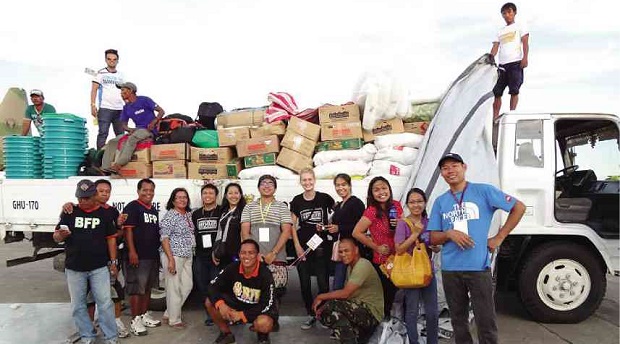
Project Sunshine aims to feed the survivors of Supertyphoon “Yolanda” with quality, nutritious, delicious food. It also encourages youth participation in nation-building through volunteerism.
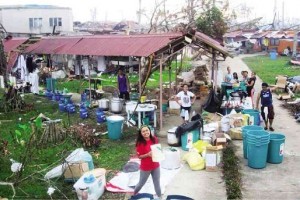
The project is the brainchild of two youth leaders, Bianca De Mesa and Maryl Robleza, and chef consultant/product endorser Michael Bautista. Bianca said, “I realized that these people need something beyond relief goods and other things that money can buy; they need hope, they need people willing to listen so they will not have fears of getting neglected. ”
Bianca made arrangements with the National Disaster Risk Reduction and Management Council to assist Project Sunshine with C-130 flights and logistics, while Maryl was responsible for tracking, itinerary and project flow. Chef Michael—who’s from Tacloban and also a Yolanda survivor—handled the supply chain, which included raw ingredients and cooking equipment. Gigantic kawali and kaldero were provided by his friends, who even gave 16 tons of frozen bangus. The team was able to bring a ton of bangus for the mission.
As a regular volunteer in Villamor Air Base, I never thought of going to Leyte until chef Leila talked about it in one of our shifts. I asked if they needed donations. I posted a status on Facebook, and a friend of mine, Karen, quickly responded. The money she donated was used to purchase heavy-duty gas burners and disinfectants. Then chef Leila asked me if I can come along to Leyte. I said yes.
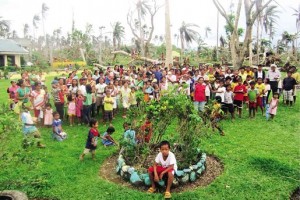
On Friday, I stayed for the graveyard shift in Villamor as a volunteer for Art Relief Mobile Kitchen. We were told that two C-130s will be flying to Tacloban at 1:30 p.m. While waiting, I helped out in the kitchen—cooking, distributing food and coordinating for the shift.
When it was time to leave, our group was split into two—the first group would ride the Japanese C-130, the next group would ride the Philippines’ own C-130.
100 boxes of ‘bangus’
Chef Leila said, “We were told that we cannot bring all the food… I really pleaded with the ground commanders for the 100 boxes of bangus. Suzanne and Maryl were also persuasive and persistent.”
Maryl added, “Bringing the supplies to Leyte was a pain in the butt, but it was a good thing that we got trucking support from Megawide, where I work. Our drivers patiently collected all donations and used our home as a temporary warehouse of the food ingredients. Crunch time at Villamor was stressful but worth it. Our Air Force heroes supported the mission and allowed all the goods aboard the Philippine C-130 despite the additional weight. The truckload of bangus—prepacked as escabeche, relleno, sisig, daing and breaded—that came all the way from Pulilan, Bulacan, arrived late and almost didn’t make it to the plane. But God paved the way for everything to turn out fine.
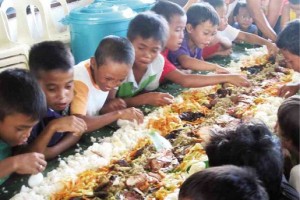
Huge pots, canned goods, milk and sacks of rice were loaded as well. We joined some 50 passengers composed of soldiers, volunteers, media and civilians.
A dump truck picked up our cargo from the airport. It was my first time in Tacloban and I could see that the airport was in shambles. Piles of relief goods from various humanitarian efforts were lined up in one area. Tents replaced cars in the parking lot.
Sitting on top of the goods en route to Palo, I took pictures from my phone camera. Trees were bent. Galvanized iron sheets, furniture items and books were being tossed into flames, smoke filling the air. Trucks and cars had toppled over.
A group of people had gathered, as if waiting for relief goods. There were debris and waste everywhere. Ruins were painted with messages: “Tindag Palo,” “Bangon Leyte,” “Help us.”
At 6 p.m. the roads were enveloped in darkness, the only light emanating from flickering candles and rechargeable lamps in some houses. Never in my life have I seen such a gloomy and wrecked place.
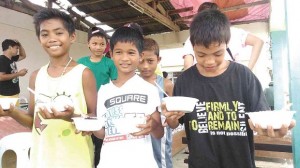
Waiting shed as kitchen
The other group composed of Bianca, Arlene, Benedick and Nelson went to Jaro, Leyte, an hour’s drive from Palo, for relief distribution.
We arrived at Barangay Salvacion in Palo at around 8 p.m. We carried boxes and sacks of goods to a waiting shed which became our kitchen for two days.
Chef Leila said, “As a culinarian, we’re trained to assess our work environment and modify it to create a setting we can call safe and ideal, or close to ideal. I knew the situation we were about to face would challenge whatever we learned in culinary school.”
While preparing dinner, we discussed our plan for feeding the people. Then we slept in a tent and set our alarm clocks at 3 a.m.
As chef Leila recalled, “We were met by 3,000 survivors who were all tired of eating canned sardines and porridge. I was truly thankful we were able to bring in the boxes of milkfish! Preparing our set menu was another challenge. At one point, we ran out of LPG and had to gather wood, but which turned out to be unsuited for pit cooking. Luckily, my brother-in-law Edgar from Leyte was there to help us gather the more appropriate wood.
“We had to maintain hygiene and food safety in our environment which was swarming with flies. How can one maintain food safety in such conditions? We had also been informed that there was an outbreak of E. coli (a type of lower-intestine bacteria) in Tacloban, so we were careful in using water for cooking,” chef Leila said.
Slicing veggies for 3 hours
The volunteers had their own roles in the kitchen. Karen and Amelie, a Danish volunteer (See related story on Page G4), and I were in charge of putting in place the food ingredients. We were slicing vegetables from 3 to 9 a.m. Maryl washed the dishes. Suzy did the inventory and was the errand girl. JP assisted the chefs in cooking.
At 10 a.m. we were ready to serve champorado and sopas (macaroni soup) for the residents of Barangay Salvacion. A volunteer directed human traffic so that the food could be served in batches. The children were given a bowl each of champorado and sopas. A mother approached me and said, “Salamat po sa sopas kasi po sawa na kami sa lugaw.” We served 2,000 bowls of champorado and sopas.
After eating, the survivors proceeded to the area where relief goods were being distributed. The people patiently waited under the heat of the sun.
Then we were back in the kitchen to cook for dinner. We were expected to feed 700 to 1,000 residents. Some of the mothers walked by, asking if they could help. I asked if they could wash the fish, and some volunteered to slice the vegetables. A group of teenagers wanted to help fry the fish.
Helping as a way of coping
This was community in action. We did not expect the barangay’s residents to help us despite their condition. Helping out became their way of coping with trauma after Yolanda.
That night, we had a debriefing of sorts because the experience was exhausting not only physically but also mentally, emotionally and spiritually. We started with a prayer and then talked about our tasks, laughing at our mistakes and mishaps, summarized how the day went and discussed how we will proceed with Day 2.
The next morning, our team had to deal with the prospect of LPG and food ingredients running out. We managed to pull off the boodle fight concept for our next partner community; about 1,000 people enjoyed the fiesta-like setup.
Gilda Radner once said, “Some stories don’t have a clear beginning, middle and end. Life is about not knowing, having to change, taking the moment, making the best of it, without knowing what’s going to happen next. Delicious ambiguity.”
That captured the essence of our journey, made more delicious with food and meaningful encounters with the people of Leyte.








































